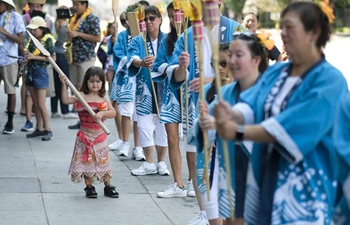LHASA, Aug. 16 (Xinhua) -- A group of archaeologists are leading field explorations of prehistoric ruins in the high-altitude region of sparsely populated west Tibet.
Over 30 specialists from Tibet and other provinces are leading the field trips in Ngari Prefecture, located 4,500 meters above sea level in the west part of the Tibet Autonomous Region.
The experts are from Tibet's regional cultural protection research institute, Chinese Academy of Social Sciences, Shaanxi Archaeology Institute, School of History and Culture of Sichuan University, and Northwest University.
The large-scale field explorations, the first of their kind, aim to explore the early civilizations of the Qinghai-Tibet Plateau, said Shaka Wandu, an assistant researcher with Tibet's regional cultural protection research institute.
Current studies in early civilizations from the Qinghai-Tibet Plateau, particularly the Shangshung civilizations, are mainly focused on the archives, linguistics, religious and anthropological fields, while archaeological studies are lacking, experts said.
Previous excavation efforts showed that Tibet had extensive exchanges with central and southern Asian regions, he said.
"We aim to expand the plateau archaeology to help us understand the early history of Tibet, particularly the Shangshung culture," he said.
"Most of us know that Tibet's main burial custom is the sky burial, but we discovered that tombs were a very common existence in ancient Tibet," said Zhang Jianlin, a professor with the Shaanxi Archaeology Institute.
In the past 20 years, dozens of tombs were found in the Ngari Prefecture. Numerous artifacts made from bronze, gold, wood and glass beads were unearthed. A gold mask from the second century and pieces of silk and tea from the third century were among the most prominent findings.
The tombs found in Ngari Prefecture date back between 1,500 BC and the fourth century AD. They were built with stones, wooden sheds and through digging pathways and caves beneath the ground, Zhang said.
Findings from the tombs carry information about the lifestyles, production habits, culture, and social exchanges in ancient Tibet.
"For example, we try to understand the burial postures for people in the coffin. By analyzing the bone structures, we try to determine whether the prehistoric residents rode horses or mainly walked and whether the artifacts and grains were locally made or imported," said Zhang.
In July last year, a tomb believed to be the earliest in western Tibet was found at the Gadpa Serrul remains, located in Zada County.
The tomb was built 3,560 and 3,000 years ago. Over 300 relics made from ceramic, stone, bone, copper, iron, wood, glass, shells and leather were found from the area. There were 100 human and animal skeletons, and archaeologists also found charcoal and seeds.
In Tibet, ancient remains are poorly conserved, and field trips are frequently hampered by harsh weather.
"It has been difficult to look for and identify a tomb area because of geological changes over the years, so it may take many years for us to complete the research into the Gadpa Serrul remains," said Shaka Wandu.
The trips are expected to last until September this year if weather permits. In the meantime, laboratory analysis of the findings is being carried out.

















